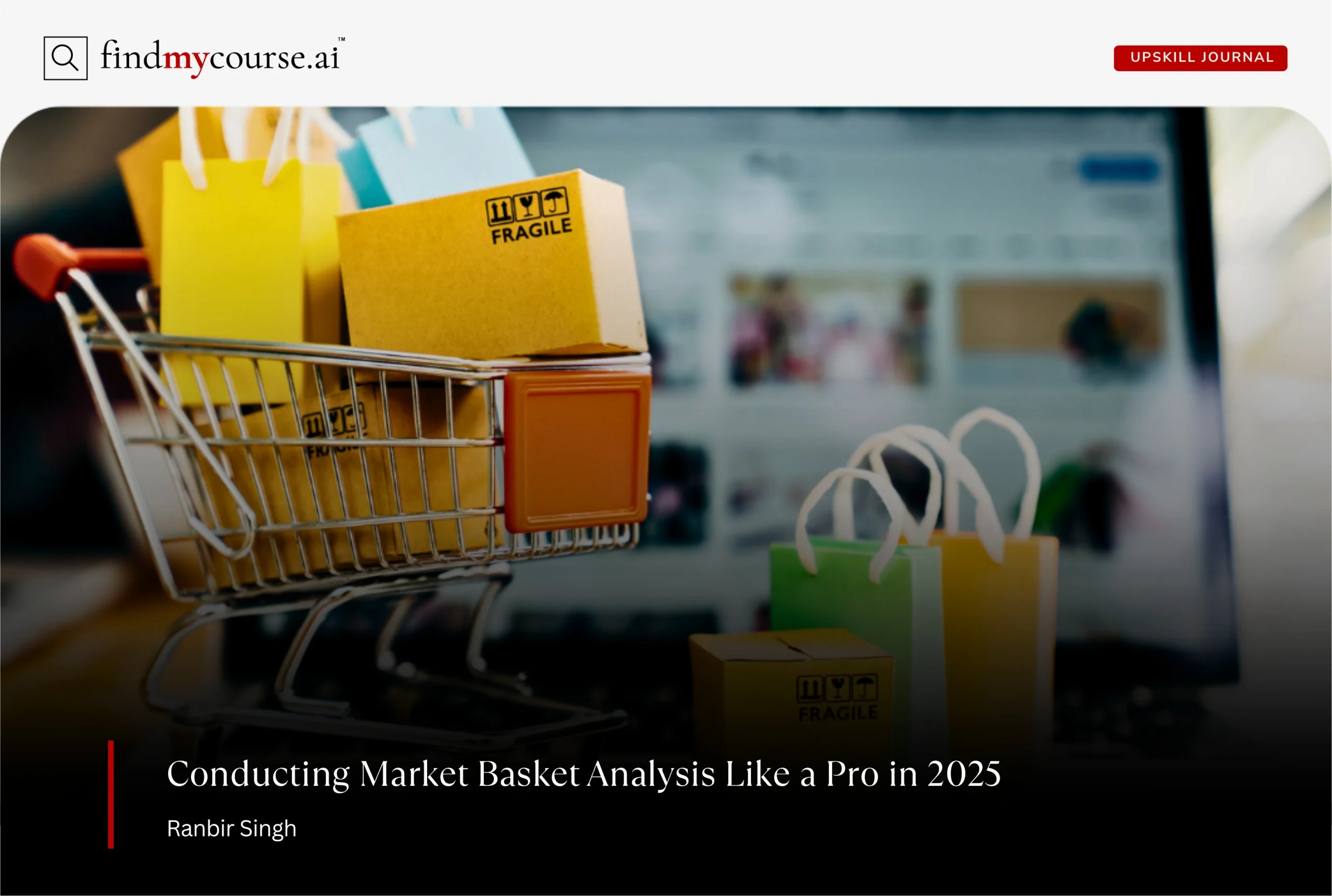Have you ever added one item to your online shopping cart only to see “Customers also bought…” suggestions you couldn’t resist? That’s not coincidence—it’s market basket analysis at work. This powerful data technique uncovers the hidden connections between products, revealing patterns that businesses use to boost sales and personalize your experience.
For professionals, learning how to conduct a market basket analysis is more than a technical skill—it’s a business advantage. Whether you’re in retail, e-commerce, finance, or healthcare, the ability to turn customer behavior into actionable insights can set you apart. In this guide, we’ll break down what it is, its Modern Applications, and the exact steps you can take to apply it effectively in your work.
What Is Market Basket Analysis?
At its core, market basket analysis is a data mining technique used to uncover patterns in customer purchasing behavior. Imagine you walk into a supermarket and buy bread, peanut butter, and jam. If many customers buy these items together, the system recognizes a pattern. Businesses can then use this knowledge to optimize product placement, recommend complementary products, or even design targeted promotions.
In simple terms, this analysis identifies associations between products. It answers the question: If a customer buys X, how likely are they to buy Y as well?
For professionals in marketing, retail, e-commerce, or data science, understanding this concept isn’t just technical—it’s strategic. It’s about connecting data to decisions that boost revenue and improve customer satisfaction.
Steps to Conduct a Market Basket Analysis
Now that we’ve covered the “why,” let’s explore the “how.” Conducting a market basket analysis involves structured steps that ensure accuracy and actionable results.
1. Define the Objective
Every analysis starts with clarity. Ask yourself: what decisions will this analysis support? Are you aiming to increase online conversions, optimize promotions, or understand customer segments? Defining the end goal ensures your work stays focused. You can use tools like Power BI or Tableau to visualize key metrics and apply the SMART goal framework to make your objectives specific and actionable.
2. Collect and Clean Data
The quality of your analysis depends on the quality of your data. Gather transactional data that captures customer purchases. For instance, in a retail store, this might be receipts. Online, it could be clickstream and order data.
Cleaning the data involves removing duplicates, handling missing values, and ensuring consistent formatting. Although it may feel tedious, this step is non-negotiable—it sets the stage for meaningful insights. Tools like Python’s pandas library can help preprocess large datasets efficiently, while SQL is ideal for extracting and organizing transaction data.
3. Organize Data into Baskets
Each “basket” represents a single transaction. For example, if a customer buys milk, cereal, and bananas in one order, that becomes one basket. Structuring the dataset this way allows algorithms to identify patterns across thousands or even millions of baskets. Python’s mlxtend library can help convert transactions into basket format, and R’s arules package is also effective for preparing datasets for association rule mining.
4. Apply Association Rule Mining
This is where the analysis comes alive. The most common algorithm used is the Apriori algorithm, which identifies frequent item sets and generates rules such as:
“If a customer buys milk and cereal, they are 70% likely to also buy bananas.”
The rules are evaluated using three key metrics:
- Support: How often the items appear together in transactions.
- Confidence: The likelihood of buying item Y when item X is purchased.
- Lift: The strength of the association compared to random chance.
Together, these metrics help separate meaningful patterns from noise.
5. Interpret and Act on Results
The final step is turning numbers into strategy. For example, a market basket analysis might reveal that customers who buy pasta frequently purchase wine. A supermarket could then create bundle promotions or place these items closer on shelves.
Remember: insights are only valuable if acted upon. Visualization tools like Google Charts help present patterns clearly and interactively for stakeholders, while Excel dashboards can be used to communicate actionable findings across teams.
Common Mistakes to Avoid in Market Basket Analysis
Even experienced professionals can stumble when conducting a market basket analysis. Here are some pitfalls to watch out for:
- Skipping data cleaning: Inaccurate or duplicate transaction data can produce misleading patterns. Always ensure your dataset is complete and consistent.
- Focusing only on high-support items: Rare but meaningful associations may be overlooked if you consider only frequently purchased items.
- Ignoring business context: Not every statistically significant association is actionable. Always interpret results in the context of your goals and operations.
- Overcomplicating rules: Creating too many rules can overwhelm decision-making. Focus on actionable insights that align with your objectives.
- Neglecting validation: Test your findings before implementing changes. Pilots or A/B tests help confirm that insights actually improve outcomes.
By being aware of these common mistakes, you can ensure your analysis is accurate, relevant, and impactful.
Real-Life Market Basket Analysis Example
One of the most cited market basket analysis example in analytics circles is the famous “diapers and beer” case. In the early 1990s, researchers analyzing point-of-sale data from a Midwestern U.S. supermarket chain noticed that customers buying diapers—particularly in the evenings—were also more likely to purchase beer.
At first, the link seemed unusual. But the explanation made sense: many young parents were picking up diapers after work and adding beer to their basket for the weekend. The insight demonstrated how analyzing transaction data can reveal unexpected patterns in customer behavior.
Beyond Supermarkets: Modern Applications of Market Basket Analysis
The value of market basket analysis isn’t limited to grocery aisles—it’s shaping strategy across industries in powerful ways:
- E-commerce: Online retailers like Amazon pioneered the “Frequently Bought Together” feature, powered by association rules. By suggesting complementary items—say, a phone case with a smartphone—these recommendations not only improve customer convenience but also contribute significantly to upsell and cross-sell revenue.
- Healthcare: Hospitals and clinics use the technique to analyze patient treatment patterns. For instance, if data shows that patients prescribed a certain medication often require a specific diagnostic test or therapy, providers can design better care pathways and anticipate needs more effectively. This translates into improved patient outcomes and more efficient resource allocation.
- Finance: Banks and fintech companies employ market basket analysis to understand which financial products tend to be adopted together. For example, customers opening a checking account may frequently sign up for a debit card and later a savings plan. Identifying these bundles helps institutions create targeted product offers and smoother onboarding experiences.
These examples prove that this is not just a theoretical exercise, but a practical, versatile method that uncovers hidden connections and drives measurable business results.
Conclusion
Conducting a market basket analysis is more than a technical exercise—it’s a pathway to understanding customer behavior and making smarter business decisions. By following the steps outlined in this guide, professionals can uncover hidden product associations, optimize offerings, and create targeted strategies that drive measurable results. Whether in retail, e-commerce, or beyond, mastering this method equips you to transform raw transaction data into actionable insights. Embracing market basket analysis not only strengthens business outcomes but also enhances your skills and career potential—and if you have any questions or need guidance on this, our AI assistant is here to help.


